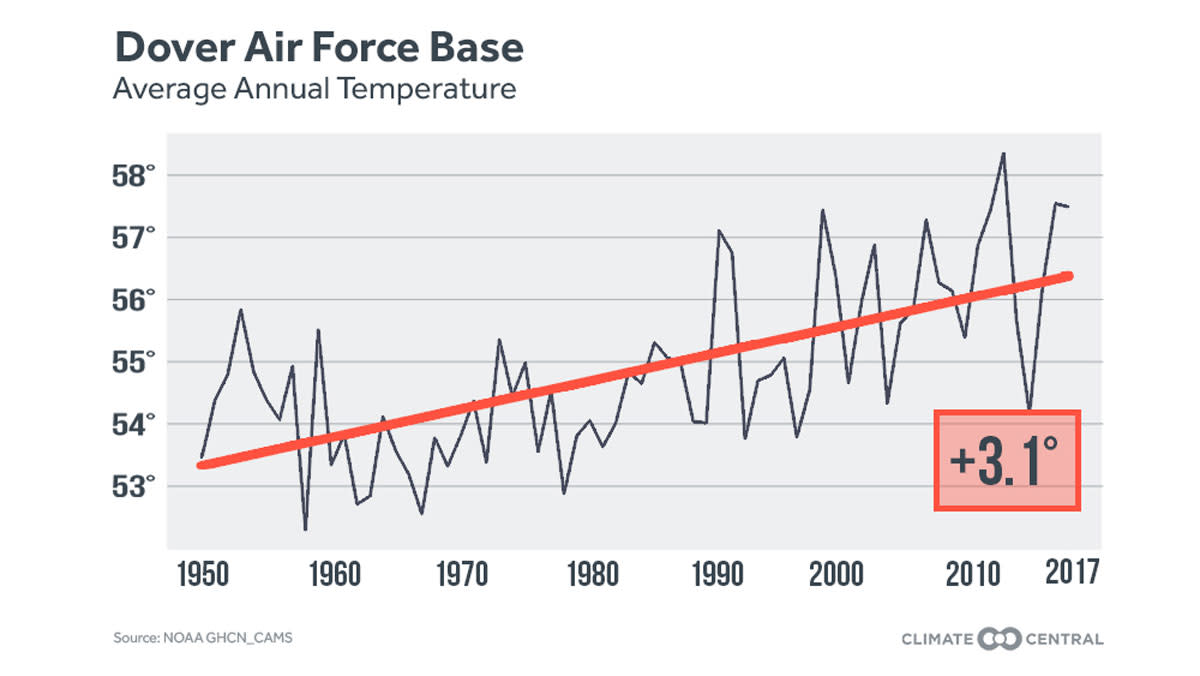KEY POINTS
November 11 is Veterans Day — and the military faces a climate challenge right here at home
Military sites across the United States have seen a striking warming trend
That warming contributes to damaging extreme weather events, from storms to droughts
In mid-October, Hurricane Michael tore into Tyndall Air Force Base in the Florida panhandle, ripping the roofs from buildings, forcing the base’s evacuation, and causing what the Air Force called “catastrophic damage.” Weeks earlier, in September, a wildfire forced the evacuation of a Marine Corps training center in California.
This Veterans Day, it’s worth remembering that climate change and the extreme weather it exacerbates are already affecting the U.S. military — right here at home.
41 of 50 U.S. states are home to a military installation that has been negatively affected by drought, according to a survey conducted by the Department of Defense between 2013 and 2015. And on the U.S. coast, a sea-level rise of roughly three feet — less than historical carbon emissions have already locked in — is projected to put nearly 130 installations at risk of damage from tidal floods and storm surges.
Behind such developments is a striking warming trend. Climate Central analyzed the average temperature trend at 100 military sites across the country, and found that all 100 have seen warming since 1950. The five locations that have warmed the fastest are all in Alaska and California: Eielson Air Force Base and Fort Wainwright, both in Alaska, have warmed almost five degrees since 1950. California’s Edwards Air Force Base — where the Air Force trains test pilots — has seen warming of 4.4 degrees. On the East Coast, Fort Bragg, North Carolina, which is the largest military installation in the United States by population, has warmed by 2.6 degrees. (The bases in the analysis were chosen based on their Plant Replacement Value, a measure that serves as a good proxy for size, importance, and population.)
Warming can make hurricanes more powerful, heighten the risk of drought, and increase the damage done by storm surges. It can make extreme heat more likely—which in turn can cause “black flag” conditions, when the military deems it too hot for service members to train outdoors.
“For DoD, it's all about the mission, and to protect their ability to perform their mission, they know they're going to have to adapt to climate change — to flooding, to drought, to extreme weather and wildfires,” said John Conger, Director of the Center for Climate and Security. “They know they can't count on 500 year storms to come every 500 years anymore. They have to improve their resilience now.”
The challenge posed by climate change and extreme weather to the U.S. military is global. More than half of the 3,500 U.S. military sites around the world have already reported damage from droughts, high winds, flooding, wildfires, or extreme temperatures, according to the Department of Defense.
Of course, climate change doesn’t just affect the sites where service members live and train. It also is beginning to shape their missions. U.S. forces can be called to respond to natural disasters, as they did during Hurricane Harvey in 2017. And in the decades ahead, climate change will stress food and water resources in regions like the Middle East and the Horn of Africa, deepening the instability of parts of the world that have already seen extensive conflict—and where U.S. forces are alreadydeployed.
“Climate change is a threat multiplier, amplifying instabilities we face around the globe, from immigration and food insecurity to terrorism and great power competition with Russia and China,” said Sherri Goodman, a Senior Fellow at the Wilson Center’s Environmental Change and Security Program and Polar Initiative. “As Secretary of Defense Mattis has said, ‘Climate change is impacting stability in areas of the world where our troops are operating today.’”
FOR MORE INFORMATION:
The Center for Climate and Security: A nonpartisan resource on climate and security risks
The U.S. Military on the Front Lines of Rising Seas: An in-depth report on sea level rise and military bases by the Union of Concerned Scientists
Military Installations, Ranges, and Training Areas: A downloadable dataset with geographic information about major U.S. military sites
